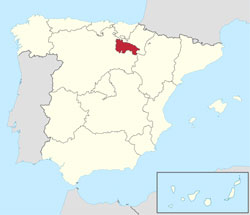Logroño in La Rioja
![]()
La Rioja is probably one of the most famous regions in Spain, known all over the world for its wine production. It is home to the wines produced under the classification ‘Denomación de Origen Calificada Rioja’.
 It is a single-province autonomous region in northern Spain, and it borders on the Álava province in the Basque Country, the region of Navarra, Zaragoza in Aragón and Burgos and Soria in Castilla y León.
It is a single-province autonomous region in northern Spain, and it borders on the Álava province in the Basque Country, the region of Navarra, Zaragoza in Aragón and Burgos and Soria in Castilla y León.
The highest point in La Rioja is Monte San Lorenzo which reaches 2,271 MASL. The region is traversed by seven rivers and is also known as ‘The Seven Valleys Region’. The river Ebro runs through the region for a 120 km stint; it enters the region at 445 MASL and leaves at 260, obviously travelling at great speed.
The area north of the Ebro is known as Rioja Alta, which has a mild, rainy climate. The southern part is Rioja Baja which is hotter and drier.
Apart from wine, La Rioja is also famous for the large amount of dinosaur footprints that can be found in the region, and there are several ‘dinosaur trails’ with models of dinosaurs scattered over the countryside.
About 40% of La Rioja’s territory is protected natural space, which makes it one of the regions with the highest percentage; the natural spaces amount to 3.56 of the national total although it is one of Spain’s smallest regions, the smallest on the Iberian Peninsula.
The city of Logroño is the capital of La Rioja and home to 151,113, almost half, of the region’s 315,675 souls.
Historically, Logroño has always been a place of passage, both by the River Ebro and several roads and trails which lead through it, the most famous of which is undoubtedly the Camino de Santiago. In the Middle Ages it was a point of dispute between the old Spanish kingdoms of Castile, Navarra and Aragón due to its situation near the borders of them all, turning it into a strategically important city.
The climate in Logroño is influenced by the passing of the River Ebro which runs through its northern part. The annual average temperature is mild, about 14ºC, although in winter it often drops below zero, and in summer it rises to the mid-thirties. The average annual rainfall is 400 mm.
Logroño constituted an important place of passage already in Roman times, and a large mooring place situated by the nearby Monte Cantabria kept the old town’s trade alive up until the 11th century.
The status of the city grew in the Middle Ages with its strategic importance. In 1521 it was laid under siege by a French general together with the forces of Enrique II of Navarra. The city council sent the following missive to the general: ‘Logroño will not open its gates to the enemy as long as there is one citizen left who is able to fight. We will defend ourselves till death’.
Logroño was under attack with artillery fire and troop assaults, and the city withstood it for two weeks. But realizing that it would not be able to hold out forever, some brave citizens penetrated the French encampment during the night of 10th June spreading fear and confusion together with the rumour that the Duke of Nájera was on his way with 20,000 soldiers.
This was enough to spook the French and Navarrans, and the very next day they broke camp and left.
This was celebrated the day after, and ever since the celebration has been repeated every year on 11th June near the old City Gate, Arco del Revellín.
Today Logroño is mainly noted for its ‘tapas trail’ which is chiefly found in calle Laurel, which is famous all over Spain. There are some 60 establishments where you can sample the succulent Rioja gastronomy and their excellent wines – or any other drink that takes your fancy.
The street got its name (Bay Leaf Street) because in the old days it was where the cortesans lived, and in order that their clients would know whether or not they were available, they would hang a twig of bay leaves from their balconies when they were free. In times of crisis almost all the balconies had bay leaves hanging from them, thus giving the street its name.
But there is much more to Logroño than food and wine; it is home to a wealth of monuments and history, and its inhabitants are always friendly and welcoming to any stranger visiting.


